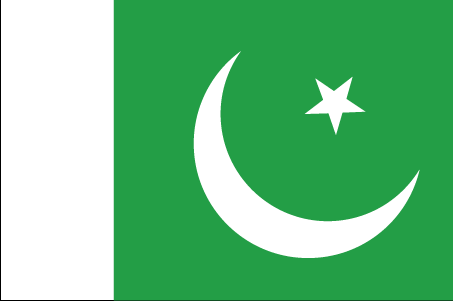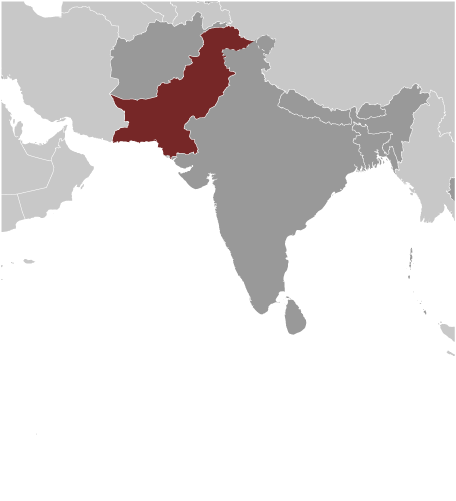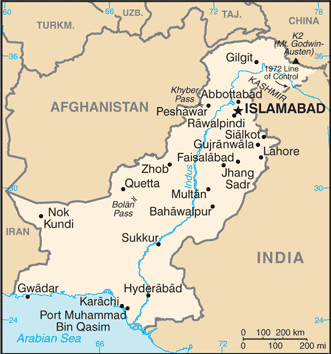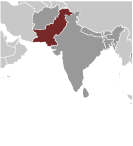
|
|
Advertisements:
EconomyEconomy - overview
Decades of internal political disputes and low levels of foreign investment have led to slow growth and underdevelopment in Pakistan. Agriculture accounts for more than one-fifth of output and two-fifths of employment. Textiles account for most of Pakistan's export earnings, and Pakistan's failure to expand a viable export base for other manufactures has left the country vulnerable to shifts in world demand. Official unemployment is 6%, but this fails to capture the true picture, because much of the economy is informal and underemployment remains high. Over the past few years, low growth and high inflation, led by a spurt in food prices, have increased the amount of poverty - the UN Human Development Report estimated poverty in 2011 at almost 50% of the population. Inflation has worsened the situation, climbing from 7.7% in 2007 to more than 13% for 2011, before declining to 9.3% at year-end. As a result of political and economic instability, the Pakistani rupee has depreciated more than 40% since 2007. The government agreed to an International Monetary Fund Standby Arrangement in November 2008 in response to a balance of payments crisis. Although the economy has stabilized since the crisis, it has failed to recover. Foreign investment has not returned, due to investor concerns related to governance, energy, security, and a slow-down in the global economy. Remittances from overseas workers, averaging about $1 billion a month since March 2011, remain a bright spot for Pakistan. However, after a small current account surplus in fiscal year 2011 (July 2010/June 2011), Pakistan's current account turned to deficit in the second half of 2011, spurred by higher prices for imported oil and lower prices for exported cotton. Pakistan remains stuck in a low-income, low-growth trap, with growth averaging 2.9% per year from 2008 to 2011. Pakistan must address long standing issues related to government revenues and energy production in order to spur the amount of economic growth that will be necessary to employ its growing population. Other long term challenges include expanding investment in education and healthcare, and reducing dependence on foreign donors. Gdp (purchasing power parity) World Ranking: 28
$494.8 billion (2011 est.)
$483.3 billion (2010 est.) $465.8 billion (2009 est.) Note Data are in 2011 US dollars Gdp (official exchange rate)
$210.6 billion (2011 est.)
Gdp - real growth rate World Ranking: 140
2.4% (2011 est.)
3.8% (2010 est.) 1.7% (2009 est.) Gdp - per capita (ppp) World Ranking: 174
$2,800 (2011 est.)
$2,800 (2010 est.) $2,800 (2009 est.) Note Data are in 2011 US dollars Gdp - composition by sector
Agriculture 20.9%
Industry 25.8% Services 53.3% (2011 est.) Labor force World Ranking: 10
58.41 million
Note Extensive export of labor, mostly to the Middle East, and use of child labor (2011 est.) Labor force - by occupation
Agriculture 45%
Industry 20.1% Services 34.9% (2010 est.) Unemployment rate World Ranking: 57
5.6% (2011 est.)
5.6% (2010 est.) Note Substantial underemployment exists Population below poverty line
22.3% (FY05/06 est.)
Household income or consumption by percentage share
Lowest 10% 9.9%
Highest 10% 39.3% (FY07/08) Distribution of family income - gini index World Ranking: 112
30.6 (FY07/08)
41 (FY98/99) Investment (gross fixed) World Ranking: 144
11.8% of GDP (2011 est.)
Budget
Revenues $26.3 billion
Expenditures $40.2 billion (2011 est.) Taxes and other revenues World Ranking: 204
12.5% of GDP (2011 est.)
Budget surplus (+) or deficit (-) World Ranking: 179
-6.6% of GDP (2011 est.)
Public debt World Ranking: 41
60.1% of GDP (2011 est.)
61.4% of GDP (2010 est.) Inflation rate (consumer prices) World Ranking: 197
11.9% (2011 est.)
12.9% (2010 est.) Central bank discount rate World Ranking: 15
12% (31 January 2012 est.)
14% (31 December 2010 est.) Commercial bank prime lending rate World Ranking: 54
14.42% (31 December 2011 est.)
14.12% (31 December 2010 est.) Stock of narrow money World Ranking: 43
$56.34 billion (31 December 2011 est.) $62.02 billion (30 June 2010)Stock of broad money World Ranking: 59
$76.16 billion (31 December 2011 est.) $85.22 billion (31 December 2010 est.) Stock of domestic credit World Ranking: 56
$75.06 billion (31 December 2011 est.) $64.53 billion (31 December 2010 est.) Market value of publicly traded shares World Ranking: 54
$32.76 billion (31 December 2011) $38.17 billion (31 December 2010) $33.24 billion (31 December 2009) Agriculture - products
Cotton, wheat, rice, sugarcane, fruits, vegetables; milk, beef, mutton, eggs Industries
Textiles and apparel, food processing, pharmaceuticals, construction materials, paper products, fertilizer, shrimp Industrial production growth rate World Ranking: 98
3% (2011 est.)
Electricity - production World Ranking: 33
93.35 billion kWh (2010 est.)
Electricity - consumption World Ranking: 37
74.35 billion kWh (2010 est.)
Electricity - exports
0 kWh (2011 est.)
Electricity - imports
0 kWh (2009 est.)
Oil - production World Ranking: 57
64,950 bbl/day (2010 est.)
Oil - consumption World Ranking: 34
410,000 bbl/day (2010 est.)
Oil - exports World Ranking: 83
29,840 bbl/day (2009 est.)
Oil - imports World Ranking: 30
346,400 bbl/day (2009 est.)
Oil - proved reserves World Ranking: 55
313 million bbl (1 January 2011 est.) Natural gas - production World Ranking: 21
42.9 billion cu m (2011 est.)
Natural gas - consumption World Ranking: 22
42.9 billion cu m (2011 est.)
Natural gas - exports World Ranking: 157
0 cu m (2009 est.)
Natural gas - imports World Ranking: 108
0 cu m (2009 est.)
Natural gas - proved reserves World Ranking: 28
840.2 billion cu m (1 January 2011 est.) Current account balance World Ranking: 50
$268 million (2011 est.)
-$3.94 billion (2010 est.) Exports World Ranking: 69
$25.35 billion (2011 est.)
$21.47 billion (2010 est.) Exports - commodities
Textiles (garments, bed linen, cotton cloth, yarn), rice, leather goods, sports goods, chemicals, manufactures, carpets and rugs Exports - partners
US 14.3%, UAE 7.7%, Afghanistan 7.6%, China 7.6%, Germany 5%, UK 4.1% (2011) Imports World Ranking: 61
$35.82 billion (2011 est.)
$32.92 billion (2010 est.) Imports - commodities
Petroleum, petroleum products, machinery, plastics, transportation equipment, edible oils, paper and paperboard, iron and steel, tea Imports - partners
China 17.9%, Saudi Arabia 11.2%, UAE 11.1%, Kuwait 5.8%, Malaysia 5.7%, India 4.9%, US 4.3% (2011) Reserves of foreign exchange and gold World Ranking: 59
$18.09 billion (31 December 2011 est.) $17.21 billion (31 December 2010 est.) Debt - external World Ranking: 54
$61.83 billion (31 December 2011 est.) $56.77 billion (31 December 2010 est.) Stock of direct foreign investment - at home World Ranking: 62
$31.36 billion (31 December 2011 est.) $30.06 billion (31 December 2010 est.) Stock of direct foreign investment - abroad World Ranking: 71
$1.419 billion (31 December 2011 est.) $1.362 billion (31 December 2010 est.) Exchange rates
Pakistani rupees (PKR) per US dollar - 86.343 (2011 est.)85.194 (2010 est.) 81.71 (2009) 70.64 (2008) 60.6295 (2007) Fiscal year
1 July - 30 June
Comments
Add a new comment: |
Advertisement
Members area
Pakistan (Islamabad):
 
GPS points from Pakistan (Islamabad)
|
||||||||

 The Indus Valley civilization, one of the oldest in the world and dating back at least 5,000 years, spread over much of what is presently Pakistan. During the second millennium B.C., remnants of this culture fused with the migrating Indo-Aryan peoples. The area underwent successive invasions in subsequent centuries from the Persians, Greeks, Scythians, Arabs (who brought Islam), Afghans, and Turks. The Mughal Empire flourished in the 16th and 17th centuries; the British came to dominate the region in the 18th century. The separation in 1947 of British India into the Muslim state of Pakistan (with West and East sections) and largely Hindu India was never satisfactorily resolved, and India and Pakistan fought two wars - in 1947-48 and 1965 - over the disputed Kashmir territory. A third war between these countries in 1971 - in which India capitalized on Islamabad's marginalization of Bengalis in Pakistani politics - resulted in East Pakistan becoming the separate nation of Bangladesh. In response to Indian nuclear weapons testing, Pakistan conducted its own tests in 1998. India-Pakistan relations have been rocky since the November 2008 Mumbai attacks, but both countries are taking small steps to put relations back on track. In February 2008, Pakistan held parliamentary elections and in September 2008, after the resignation of former President MUSHARRAF, elected Asif Ali ZARDARI to the presidency. Pakistani government and military leaders are struggling to control domestic insurgents, many of whom are located in the tribal areas adjacent to the border with Afghanistan. In January 2012, Pakistan assumed a nonpermanent seat on the UN Security Council for the 2012-13 term.
The Indus Valley civilization, one of the oldest in the world and dating back at least 5,000 years, spread over much of what is presently Pakistan. During the second millennium B.C., remnants of this culture fused with the migrating Indo-Aryan peoples. The area underwent successive invasions in subsequent centuries from the Persians, Greeks, Scythians, Arabs (who brought Islam), Afghans, and Turks. The Mughal Empire flourished in the 16th and 17th centuries; the British came to dominate the region in the 18th century. The separation in 1947 of British India into the Muslim state of Pakistan (with West and East sections) and largely Hindu India was never satisfactorily resolved, and India and Pakistan fought two wars - in 1947-48 and 1965 - over the disputed Kashmir territory. A third war between these countries in 1971 - in which India capitalized on Islamabad's marginalization of Bengalis in Pakistani politics - resulted in East Pakistan becoming the separate nation of Bangladesh. In response to Indian nuclear weapons testing, Pakistan conducted its own tests in 1998. India-Pakistan relations have been rocky since the November 2008 Mumbai attacks, but both countries are taking small steps to put relations back on track. In February 2008, Pakistan held parliamentary elections and in September 2008, after the resignation of former President MUSHARRAF, elected Asif Ali ZARDARI to the presidency. Pakistani government and military leaders are struggling to control domestic insurgents, many of whom are located in the tribal areas adjacent to the border with Afghanistan. In January 2012, Pakistan assumed a nonpermanent seat on the UN Security Council for the 2012-13 term.